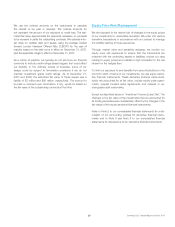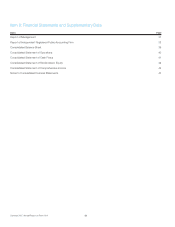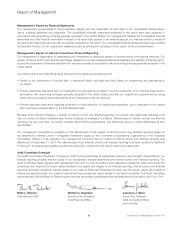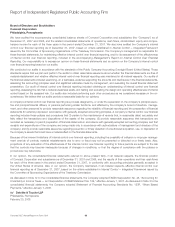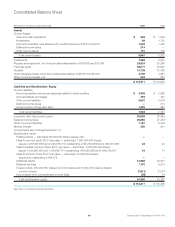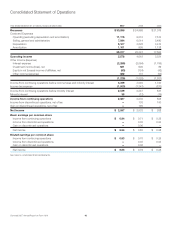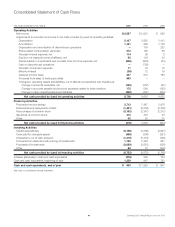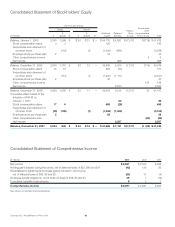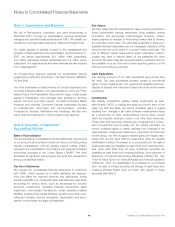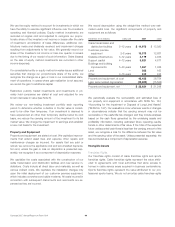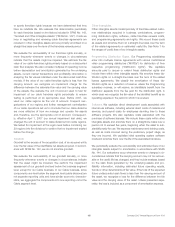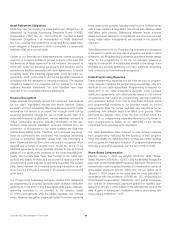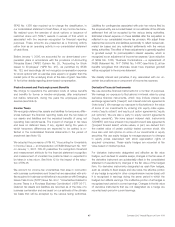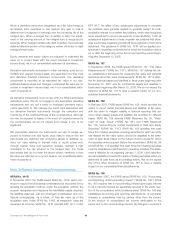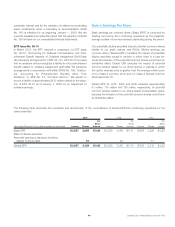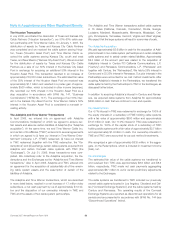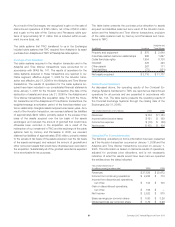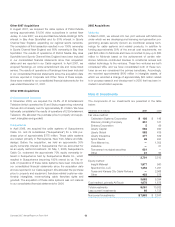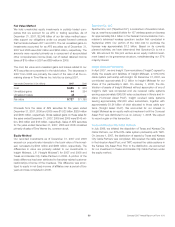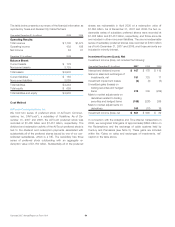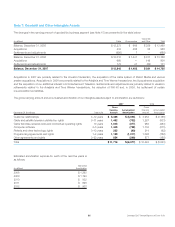Comcast 2007 Annual Report Download - page 47
Download and view the complete annual report
Please find page 47 of the 2007 Comcast annual report below. You can navigate through the pages in the report by either clicking on the pages listed below, or by using the keyword search tool below to find specific information within the annual report.or sports franchise rights because we have determined that they
have an indefinite life. We reassess this determination periodically
for each franchise based on the factors included in SFAS No. 142,
“Goodwill and Other Intangible Assets” (“SFAS No. 142”). Costs we
incur in negotiating and renewing cable franchise agreements are
included in other intangible assets and are primarily amortized on a
straight-line basis over the term of the franchise renewal period.
We evaluate the recoverability of our franchise rights annually, or
more frequently whenever events or changes in circumstances
indicate that the assets might be impaired. We estimate the fair
value of our cable franchise rights primarily based on a discounted
cash flow analysis. We also consider multiples of operating income
before depreciation and amortization generated by the underlying
assets, current market transactions and profitability information in
analyzing the fair values indicated under the discounted cash flow
models. If the value of our cable franchise rights is less than the
carrying amount, we recognize an impairment charge for the
difference between the estimated fair value and the carrying value
of the assets. We evaluate the unit of account used to test for
impairment of our cable franchise rights periodically to ensure
testing is performed at an appropriate level. Before 2007, we
used our cable regions as the unit of account. Frequent reor-
ganizations of our regions and further management centralization
of our cable operations led us to conclude that our cable divisions
are more reflective of how we manage and operate the assets
and, therefore, are the appropriate unit of account. Consequent-
ly, effective April 1, 2007 (our annual impairment test date), we
changed the unit of account to cable divisions from cable regions.
We tested for impairment at the region level before combining our
29 regions into five divisions to confirm that no impairment existed
before the change.
Goodwill
Goodwill is the excess of the acquisition cost of an acquired entity
over the fair value of the identifiable net assets acquired. In accord-
ance with SFAS No. 142, we do not amortize goodwill.
We evaluate the recoverability of our goodwill annually, or more
frequently whenever events or changes in circumstances indicate
that the asset might be impaired. We perform the impairment
assessment of our goodwill one level below the business segment
level, except for our Cable business. In our Cable business, since
components one level below the segment level (cable divisions) are
not separate reporting units and have similar economic character-
istics, we aggregate the components into one reporting unit at the
Cable segment level.
Other Intangibles
Other intangible assets consist primarily of franchise-related custo-
mer relationships acquired in business combinations, program-
ming distribution rights, software, cable franchise renewal costs,
and programming agreements and rights. We record these costs
as assets and amortize them on a straight-line basis over the term
of the related agreements or estimated useful life. See Note 7 for
the ranges of useful lives of our intangible assets.
Programming Distribution Rights. Our Programming subsidiaries
enter into multiyear license agreements with various multichannel
video programming distributors (“MVPDs”) for distribution of their
respective programming (“distribution rights”). We capitalize
amounts paid to secure or extend these distribution rights and
include them within other intangible assets. We amortize these dis-
tribution rights on a straight-line basis over the term of the related
license agreements. We classify the amortization of these dis-
tribution rights as a reduction of revenue unless the Programming
subsidiary receives, or will receive, an identifiable benefit from the
distributor separate from the fee paid for the distribution right, in
which case we recognize the fair value of the identified benefit as an
operating expense in the period in which it is received.
Software. We capitalize direct development costs associated with
internal-use software, including external direct costs of material and
services, and payroll costs for employees devoting time to these
software projects. We also capitalize costs associated with the
purchase of software licenses. We include these costs within other
intangible assets and amortize them on a straight-line basis over a
period not to exceed five years, beginning when the asset is sub-
stantially ready for use. We expense maintenance and training costs,
as well as costs incurred during the preliminary project stage, as
they are incurred. We capitalize initial operating system software
costs and amortize them over the life of the associated hardware.
We periodically evaluate the recoverability and estimated lives of our
intangible assets subject to amortization in accordance with SFAS
No. 144. Our evaluations occur whenever events or changes in cir-
cumstances indicate that the carrying amount may not be recover-
able or the useful life has changed, and they include analyses based
on the cash flows generated by the underlying assets and pro-
fitability information, including estimated future operating results,
trends or other determinants of fair value. If the total of the expected
future undiscounted cash flows is less than the carrying amount of
the asset, we recognize a loss for the difference between the fair
value and the carrying value of the asset. Unless presented sepa-
rately, the loss is included as a component of amortization expense.
45 Comcast 2007 Annual Report on Form 10-K


